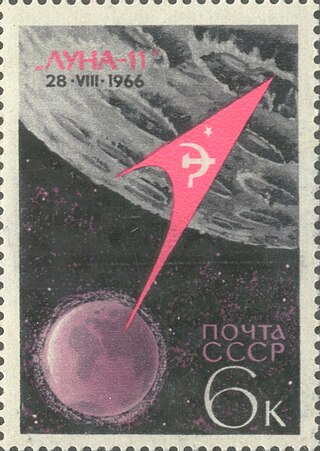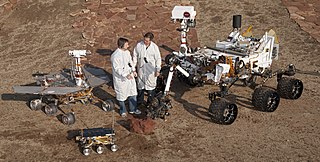
Lunokhod was a series of Soviet robotic lunar rovers designed to land on the Moon between 1969 and 1977. Lunokhod 1 was the first roving remote-controlled robot to land on an extraterrestrial body.

Lunokhod 1 was the first of two robotic lunar rovers landed on the Moon by the Soviet Union as part of its Lunokhod program. The Luna 17 spacecraft carried Lunokhod 1 to the Moon in 1970. Lunokhod 1 was the first remote-controlled robot "rover" to freely move across the surface of an astronomical object beyond the Earth. It was also the first wheeled craft on another celestial body. Lunokhod 0 (No.201), the previous and first attempt to do so, launched in February 1969 but failed to reach orbit.

Lunokhod 2 was the second of two unmanned lunar rovers that landed on the Moon by the Soviet Union as part of the Lunokhod programme.

The Luna programme, occasionally called Lunik by western media, was a series of robotic spacecraft missions sent to the Moon by the Soviet Union between 1959 and 1976. Fifteen were successful, each designed as either an orbiter or lander, and accomplished many firsts in space exploration. They also performed many experiments, studying the Moon's chemical composition, gravity, temperature, and radiation.

Luna 11 was an uncrewed space mission of the Soviet Union's Luna program. It was also called Lunik 11. Luna 11 was launched towards the Moon from an Earth-orbiting platform and entered lunar orbit on 27 August 1966.
Luna 12 was an unmanned space mission of the Luna program, also called Lunik 12.
Luna 14 was an uncrewed space mission of the Luna program run by the Soviet Union. It was also called Lunik 14.

Luna 15 was a robotic space mission of the Soviet Luna programme, that crashed into the Moon on 21 July 1969.

Luna 16 was an uncrewed 1970 space mission, part of the Soviet Luna program. It was the first robotic probe to land on the Moon and return a sample of lunar soil to Earth. The 101 grams sample was returned from Mare Fecunditatis. It represented the first successful lunar sample return mission by the Soviet Union and was the third lunar sample return mission overall.

LOK Luna 17 was an uncrewed space mission of the Luna program, also called Lunik 17. It deployed the first robotic rover onto the surface of the Moon.
Luna 18, part of the Ye-8-5 series, was an uncrewed space mission of the Luna program.
Luna 19, was an unmanned space mission of the Luna program. Luna 19 extended the systematic study of lunar gravitational fields and location of mascons. It also studied the lunar radiation environment, the gamma-active lunar surface, and the solar wind. Photographic coverage via a television system was also obtained.

Luna 20 was the second of three successful Soviet lunar sample return missions. It was flown as part of the Luna program as a robotic competitor to the six successful Apollo lunar sample return missions.
Luna 22 was an uncrewed space mission, part of the Soviet Luna program, also called Lunik 22.

Luna 23 was an uncrewed space mission of the Luna program developed by the Soviet Union.

Luna 24 was a robotic probe of the Soviet Union's Luna programme. The last of the Luna series of spacecraft, the mission of the Luna 24 probe was the third Soviet mission to return lunar soil samples from the Moon. The probe landed in Mare Crisium. The mission returned 170.1 g (6.00 oz) of lunar samples to the Earth on 22 August 1976.

A Moon landing or lunar landing is the arrival of a spacecraft on the surface of the Moon. This includes both crewed and robotic missions. The first human-made object to touch the Moon was the Soviet Union's Luna 2, on 13 September 1959.

A rover is a planetary surface exploration device designed to move across the solid surface on a planet or other planetary mass celestial bodies. Some rovers have been designed as land vehicles to transport members of a human spaceflight crew; others have been partially or fully autonomous robots. Rovers are typically created to land on another planet via a lander-style spacecraft, tasked to collect information about the terrain, and to take crust samples such as dust, soil, rocks, and even liquids. They are essential tools in space exploration.

A lunar rover or Moon rover is a space exploration vehicle designed to move across the surface of the Moon. The Apollo Program's Lunar Roving Vehicle was driven on the Moon by members of three American crews, Apollo 15, 16, and 17. Other rovers have been partially or fully autonomous robots, such as the Soviet Union's Lunokhods and the Chinese Yutus. Three countries have had operating rovers on the Moon: the Soviet Union, the United States and China. An Indian mission failed while Japan and Greece currently have planned missions.















